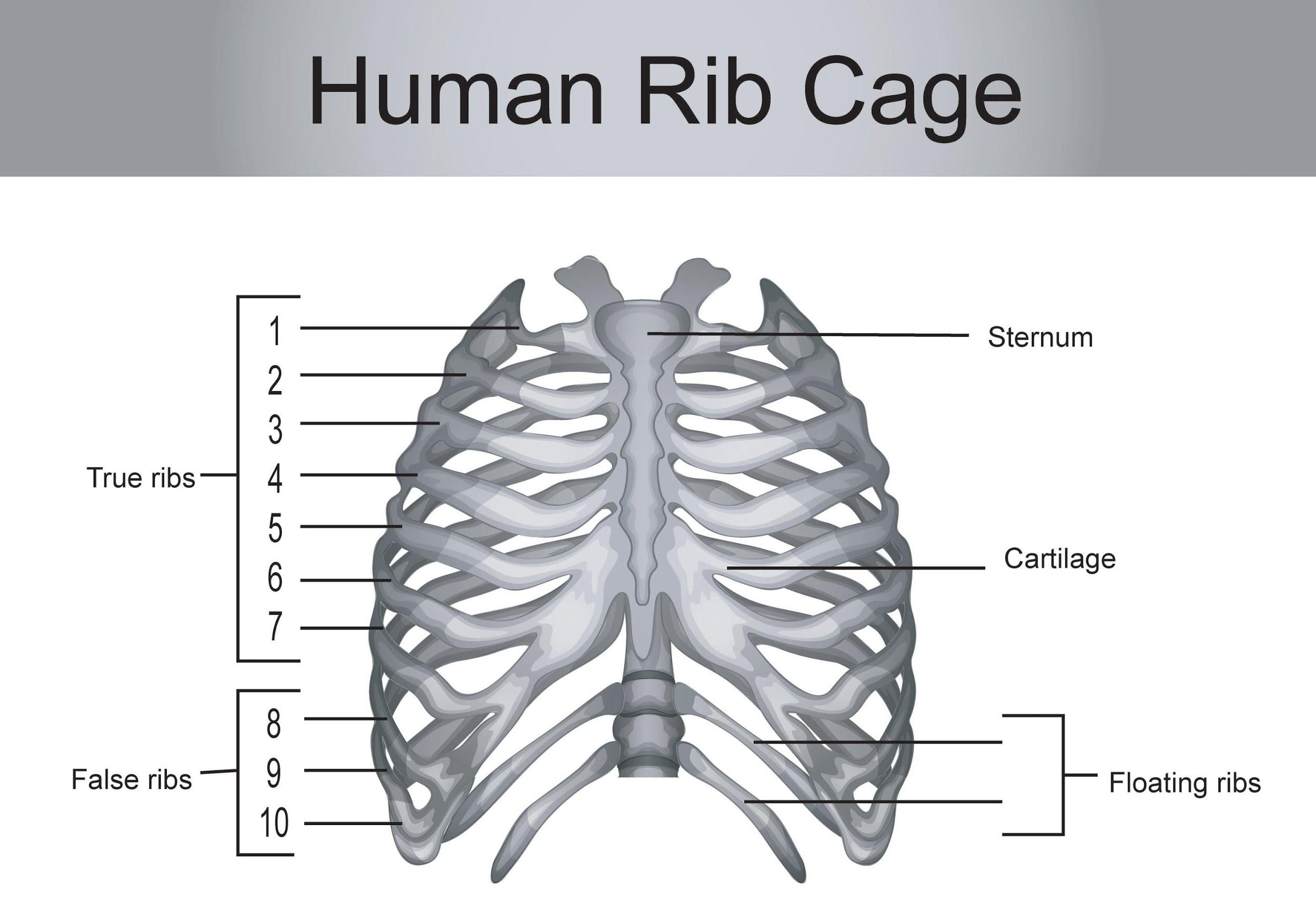
Vertebrochondral ribs in man are
(a) $8^{th}$, $9^{th}$, $10^{th}$ rib
(b) $7^{th}$, $8^{th}$, $9^{th}$ rib
(c) $9^{th}$, $10^{th}$, $11^{th}$ rib
(d) $6^{th}$, $7^{th}$, $8^{th}$ rib
Answer
561.3k+ views
Hint: Ribs are the long curved bones that make the rib cage. They articulate posteriorly with the vertebral column and terminate anteriorly as cartilage. Chest bones and backbone together form the rib cage.
Complete step by step answer:
There are 33 ribs. Each rib is a thin cut of beef connected dorsally to the vertebral column and ventrally to the sternum. It has two articulation surfaces on its dorsal end and is therefore known as bicephalic. $1^{st}$ – $7^{th}$ pairs of ribs are known as true ribs. Dorsally, they're attached to the thoracic vertebrae and ventrally connected to the sternum with the assistance of hyaline cartilage. Vertebrochondral ribs termed to the $8^{th}$ -$10^{th}$ pairs of ribs. The eighth-to-tenth pairs of ribs hook up with the sternum indirectly via the costal cartilages of the ribs above them.
Additional information: The ribs consist of twenty-four bones in twelve pairs which form the protective cage of the thorax. The ribs protect the thoracic internal organs. They articulate posteriorly with the vertebral column and terminate anteriorly as cartilage.
 - 8-12 rib pairs are attached to vertebrae posteriorly, but anteriorly they are not attached to the sternum directly. These rib pairs are called False ribs.
- The 8-10 rib pairs attach to the sternum indirectly via the costal cartilages of the ribs above them.
- The 11 and 12 rib pairs do not attach to the sternum at all. So, these two rib pairs are alternatively called the floating ribs.
- The ribs protect the thoracic internal organs.
- Vertebrae of the thoracic region have limited movement and provide support to the rib cage and protects the lungs and heart.
- 12 pairs of rib bones articulate with the thoracic vertebrae on the posterior side.
- 8-12 rib pairs are attached to vertebrae posteriorly, but anteriorly they are not attached to the sternum directly. These rib pairs are called False ribs.
- The 8-10 rib pairs attach to the sternum indirectly via the costal cartilages of the ribs above them.
- The 11 and 12 rib pairs do not attach to the sternum at all. So, these two rib pairs are alternatively called the floating ribs.
- The ribs protect the thoracic internal organs.
- Vertebrae of the thoracic region have limited movement and provide support to the rib cage and protects the lungs and heart.
- 12 pairs of rib bones articulate with the thoracic vertebrae on the posterior side.
So, the correct answer is ‘$8^{th}$, $9^{th}$, $10^{th}$ rib’.
Note: A dislocated rib can be painful and can be caused simply by coughing, or for example by trauma or lifting heavyweights. The false ribs include the floating ribs (eleven and twelve) that aren't attached to the sternum in the least. We have 12 ribs on each side of our chest. Rib Cage protects the internal parts of our body and provides a definite structure.
Complete step by step answer:
There are 33 ribs. Each rib is a thin cut of beef connected dorsally to the vertebral column and ventrally to the sternum. It has two articulation surfaces on its dorsal end and is therefore known as bicephalic. $1^{st}$ – $7^{th}$ pairs of ribs are known as true ribs. Dorsally, they're attached to the thoracic vertebrae and ventrally connected to the sternum with the assistance of hyaline cartilage. Vertebrochondral ribs termed to the $8^{th}$ -$10^{th}$ pairs of ribs. The eighth-to-tenth pairs of ribs hook up with the sternum indirectly via the costal cartilages of the ribs above them.
Additional information: The ribs consist of twenty-four bones in twelve pairs which form the protective cage of the thorax. The ribs protect the thoracic internal organs. They articulate posteriorly with the vertebral column and terminate anteriorly as cartilage.

So, the correct answer is ‘$8^{th}$, $9^{th}$, $10^{th}$ rib’.
Note: A dislocated rib can be painful and can be caused simply by coughing, or for example by trauma or lifting heavyweights. The false ribs include the floating ribs (eleven and twelve) that aren't attached to the sternum in the least. We have 12 ribs on each side of our chest. Rib Cage protects the internal parts of our body and provides a definite structure.
Recently Updated Pages
Master Class 12 Business Studies: Engaging Questions & Answers for Success

Master Class 12 Economics: Engaging Questions & Answers for Success

Master Class 12 English: Engaging Questions & Answers for Success

Master Class 12 Maths: Engaging Questions & Answers for Success

Master Class 12 Social Science: Engaging Questions & Answers for Success

Master Class 12 Chemistry: Engaging Questions & Answers for Success

Trending doubts
What is meant by exothermic and endothermic reactions class 11 chemistry CBSE

Which animal has three hearts class 11 biology CBSE

10 examples of friction in our daily life

One Metric ton is equal to kg A 10000 B 1000 C 100 class 11 physics CBSE

1 Quintal is equal to a 110 kg b 10 kg c 100kg d 1000 class 11 physics CBSE

Difference Between Prokaryotic Cells and Eukaryotic Cells




